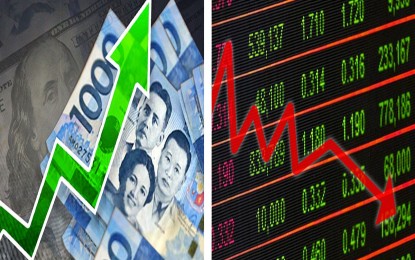
MANILA – Reports about the Philippine government’s budget surplus in June 2020 boosted the peso to its strongest in over three years but the main equities index contracted due to continued rise of coronavirus disease 2019 (Covid-19) infections.
The peso finished the day’s trade at 49.375 to a greenback, sideways from its 49.39 close a day ago.
It opened the day flat at 49.3 and traded between 49.38 and 49.295. Average level for the day stood at 49.339.
Volume totaled to USD567.13 million, lower than the USD676.25 million a day ago.
Rizal Commercial Banking Corporation (RCBC) chief economist Michael Ricafort said the peso’s close Wednesday is its strongest since November 16, 2016 when it ended the trade at 49.35 against the US dollar.
He traced the local currency’s appreciation to “the release of improved/better budget deficit data in view of more tax collections, including annual tax payments as deferred to June 2020 and some advanced tax payments by some businesses in support of the government’s Covid-19 programs.”
The Bureau of the Treasury (BTr) during the day reported that government revenues last June rose by 50.06 percent to PHP351 billion from year-ago’s PHP233.9 billion as a result of the extension of the deadline for income tax return (ITR) filing, which originally is April 15 of every year, due to the implementation of the enhanced community quarantine (ECQ).
On the other hand, revenues in the first half of the year contracted by 6.09 percent year-on-year to PHP1.45 trillion over year-ago’s PHP1.547 trillion.
Aside from this factor, Ricafort said the greenback “continued to remain weaker vs. most Asian/global currencies after US President Trump signaled that the Covid-19 could get worse before improving.”
“The US currency vs. major global currencies has been lower recently amid less demand for safe havens such as the US dollar amid improved global market risk appetite after recent positive developments on possible vaccines vs. Covid-19 and some improvement in US/economic data as more economies reopen from lockdowns, thereby overshadowing concerns over the recent spike in new Covid-19 cases in some US states/countries,” he said.
Other factors that buoyed the local currency include the ongoing sale of the government’s five-year retail treasury bond (RTB), which so far has attracted at least PHP250 billion, the bond offering of the private companies, and the introduction of the first real estate investment trust (REIT) offering in the local bourse, with the latter seen to entice some foreign buying.
Ricafort expects the peso to trade between 49.30-49.45 to a dollar Thursday
Meanwhile, the Philippine Stock Exchange index (PSEi) shed 1.17 percent, or 72.05 points, to 6,064.26 points.
It was trailed by most of the counters, with the All Shares down by 0.85 percent, or 30.63 points, to 3,569.09 points.
The Holding Firms counter posted the highest drop among the sectoral indices after it fell 1.92 percent, and was followed by the Industrial, 0.90 percent; Services, 0.66 percent; Financials, 0.48 percent; and Property, 0.43 percent.
Only the Mining and Oil gained during the day after it rose 0.70 percent.
Volume totaled to a little over 3 billion shares amounting to PHP4.5 billion.
Losers led gainers at 105 to 89, while 35 shares were unchanged.
Ricafort said PSEi’s close Wednesday is among its three-week lows “but still among the highest levels in four months amid the recent increase in new local Covid-19 cases that could slow down the economic recovery /rebound after the lockdowns.”
“Ongoing and upcoming fund-raising activities/new issuances of securities could have shifted/funneled some funds from other existing issues/securities, thereby causing some healthy profit-taking/downward correction after hefty gains in recent weeks/months,” he said.
He forecasts the main index to trade between 5,990-5,850 on Thursday. (PNA)
